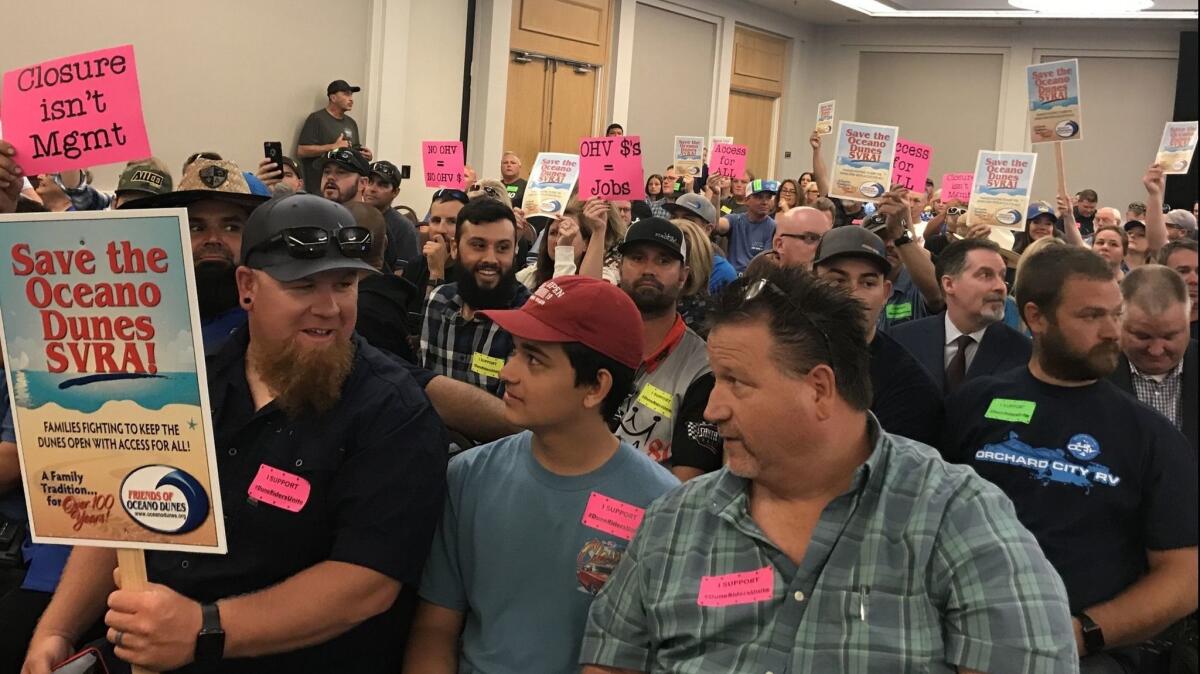Coastal Commission rejects proposal to restrict off-roading at Oceano Dunes — at least for now

- Share via
Reporting from San Luis Obispo — After six hours of heated testimony from conservationists and off-road vehicle enthusiasts, the California Coastal Commission on Thursday rejected the recommendation of its staff and voted against restricting vehicle access to Oceano Dunes — at least for the time being.
In a tense 8-2 decision, commissioners acknowledged the impacts on endangered species and air quality but agreed to give the California Department of Parks and Recreation a year to complete a management plan, along with quarterly updates as an accountability measure.
The move was hailed as a victory by off-road riders, who have fought to maintain access to the only state park that allows vehicles to zoom over its beaches and dunes. However, the action does little to resolve a decades-long conflict between two state imperatives — protecting the environment and providing open access to public recreation.
Commissioner Steve Padilla, who voted with the majority, acknowledged this dilemma before a packed room.
“This is a slow-moving environmental disaster,” he said. “It is that slow train wreck that we’re all standing there watching and we’re paralyzed about what to do about it — because we’re all under competing pressures. Big political pressure. I have friends on all sides of this issue.”
After nearly four decades of allowing vehicles under an interim permit, Coastal Commission staff last month recommended a list of restrictions the state parks department should take to reduce the environmental impacts in the near term while it begins to phase out off-highway vehicle use and transition “towards less intensive forms of public access and recreation.”
The proposal was opposed by state parks officials, who pushed the Coastal Commission to take no action and instead allow them to complete their own management plans. They insist off-roading can be balanced with conservation.
Emotions were high throughout the lengthy hearing, and sheriff’s officials stood guard at the doors, an unusual sight at commission meetings. For hours, commissioners listened to members of the public make their case. One speaker brought a 3-foot-tall stack of papers, with 175,000 signatures opposing attempts to change the beach driving rules.
At the heart of the dispute is a cultural divide over what types of beach access are valued, and both sides presented their arguments as a matter of environmental and economic justice. Off-roading proponents and local businesses accused regulators and coastal elites of looking down on a low-cost form of recreation and warned of economic harm from the loss of vehicle-related tourism. Opponents argued that their communities are the ones whose economic development, safety and health is suffering as a result of putting vehicles first.
On one side of the hearing room at a San Luis Obispo hotel sat residents and conservationists holding signs reading “No cars on the beach” and “Vote today, don’t delay.” They say off-roaders have crushed endangered species beneath their tires, disrupted sensitive habitats and sent clouds of unhealthy dust billowing into surrounding neighborhoods.
“Every day we wake up to the threat of serious air pollution,” said Paul Stolpman, a resident of the nearby Nipomo Mesa, which is hit by a fine, talcum-like dust that blows across the dunes and routinely violates health standards for particulate matter.
On the other side sat off-road enthusiasts and campers who have campaigned hard to maintain access to a cherished stretch of beach and dunes that have been a center of their community for decades. They arrived in trucks and Jeeps displaying U.S. and Confederate flags, waving signs reading “Save the Oceano Dunes” and “Closure isn’t Mgmt” — an apparent reference to ecological management.
“My family’s been doing this for 50 years,” said Jim Suty, president of Friends of Oceano Dunes, a group of off-roaders and campers that advocates against the loss of riding area. “We need you to not destroy our culture but protect it.”

Commissioners were hard pressed to reconcile the competing interests.
“The science and evidence is clear that there are adverse environmental impacts that are being caused by human activity on this site — that’s a fact, stop getting around that,” Padilla told the packed meeting room. “It’s also true that there are communities that have been adversely affected…. We have a responsibility to address this. It’s insane that this conversation has gone on for so long.”
Commissioner Sara Aminzadeh, who voted against the majority, cited this as an imperative to begin addressing the issue now, not later: “With all due respect, we have a commitment to these communities to take action. We have not taken action for years.”
The 12-member coastal panel consists of appointed and elected officials from up and down the coast who are selected by the governor and legislative leaders.
Before the hearing Thursday, the commission’s staff had already received 5,500 emails weighing in on the issue. Some 4,000 of them voiced support for the staff recommendation and 1,500 were against, including one petition with 6,000 signatures attached.
Officials with the state parks department, Natural Resources Agency and off-road supporters had also been making their case to Coastal Commission appointees through private meetings and phone calls in the days running up to Thursday’s hearing, according to last-minute disclosures by commissioners.
Politicians have also weighed in recently. Among them were House Minority Leader Kevin McCarthy (R-Bakersfield) and Rep. Devin Nunes (R-Tulare), who wrote the commission opposing staff recommendations on the grounds they would “deny our constituents and others the ability to fully access their public lands for OHV recreation” and harm the local economy.
Local officials speaking at the hearing were divided. Some pushed for continued off-highway vehicle use, predicting that removing them would devastate the restaurants and tourism-related businesses that cater to the off-roading community. But others implored the commission to take a stand to protect dune habitat and protect the health and well-being of surrounding communities.
San Luis Obispo Mayor Heidi Harmon decried the “continued assault” from dust plumes from the dunes. Air quality regulators, she said, “have so far been unable to hold state parks accountable for the human damage that its operations generate.”
“It is up to you as a commission to have the courage to do your job in the face of tremendous opposition,” Harmon said, “and it is way past time.”
In a report, Coastal Commission staff highlighted the riding areas’ disproportionate effects on neighboring towns, “particularly less affluent communities of color, [which] are forced to bear the problems and degradation associated with that use” and “receive no benefit.”
Opponents to scaling back access to the dunes have accused regulators of having a different kind of cultural bias: one against an off-roading tradition cultivated for generations, since well before the 1976 Coastal Act.
This week, the panel also received letters from 16 of its former commissioners who described a futile, decades-long struggle to address the “intractable morass” of vehicle use at the dunes. They urged current commissioners to “seize this singular opportunity” to begin transitioning Oceano Dunes “into a different kind of state park: one that complies with modern environmental laws and principles, provides safe and sustainable coastal access for diverse user groups, protects public health, and celebrates the unique natural resources of the Guadalupe-Nipomo Dunes Complex.”
The park draws roughly 2 million visitors a year, and for busy weekends and holidays, reservations can fill up six months in advance.
To access riding areas, vehicles must cross Arroyo Grande Creek, a perennial stream that empties into the ocean and supports tidewater goby and steelhead trout, fish that are listed under the federal Endangered Species Act.
The park also cordons off some 300 acres for much of the year to protect endangered snowy plovers and California least terns during breeding season. The birds, however, continue to be killed outside those areas, with some of them crushed next to tire tracks.
Among other near-term changes, the Coastal Commission staff wanted the state parks department to reduce the number of vehicles allowed in the park, prohibit them from crossing Arroyo Grande Creek when it’s flowing and make permanent the seasonal area fenced off to protect endangered species.
More to Read
Sign up for Essential California
The most important California stories and recommendations in your inbox every morning.
You may occasionally receive promotional content from the Los Angeles Times.












